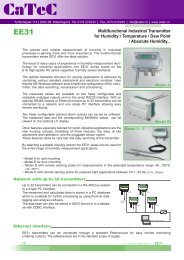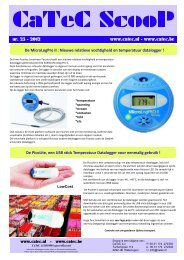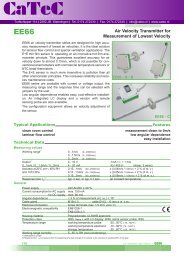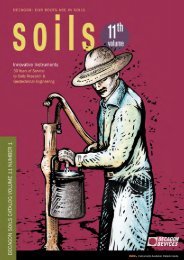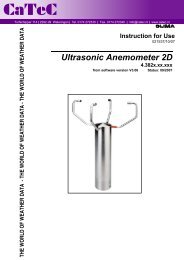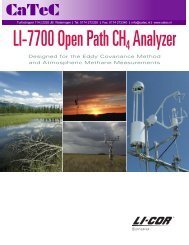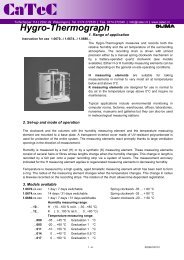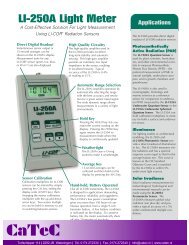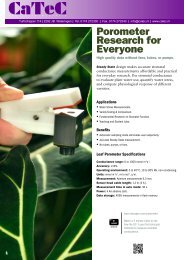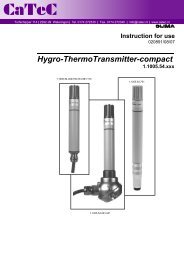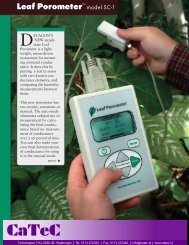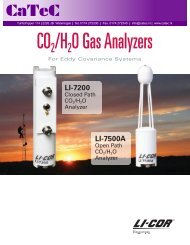li-190sa quantum sensor li-190sa quantum sensor
li-190sa quantum sensor li-190sa quantum sensor
li-190sa quantum sensor li-190sa quantum sensor
You also want an ePaper? Increase the reach of your titles
YUMPU automatically turns print PDFs into web optimized ePapers that Google loves.
OPTICAL ACCESSORIES<br />
1800-12S External Integrating Sphere: With the 1800-12S, the<br />
LI-1800 becomes an even more powerful integrating sphere<br />
based system for measurements ranging from total reflectance<br />
and transmittance to color measurements of objects. Whether<br />
you’re measuring leaf spectral properties in the field, or qua<strong>li</strong>ty<br />
control, the 1800-12S provides the portabi<strong>li</strong>ty to meet all your<br />
measurement needs.<br />
1<br />
2<br />
3<br />
For measurements on thin samples, such as leaves, paper, or<br />
cloth, the samples can be clamped onto the sample port for measurement.<br />
For surface reflectance and color measurements of<br />
larger objects, the sample clamp can be removed and the integrating<br />
sphere placed directly on the object’s surface.<br />
Measurements are taken by placing the illuminator in the reference<br />
port and taking a reference scan with the LI-1800. Barium<br />
sulfate (BaSO 4 ) is the reference material and is also used to coat<br />
the walls of the 1800-12S. After a reference scan, the illuminator<br />
is moved to the reflectance or transmittance port so the<br />
source can shine on or through the object (respectively).<br />
The reflectance or transmittance data files stored in the LI-1800<br />
are then divided by the reference data file to produce a file<br />
containing the total (diffuse plus specular) spectral reflectance or<br />
transmittance. This data can also be used to calculate the CIE<br />
chromaticity coordinates of the measured object by choosing<br />
from standard sources A, E, D65 (stored in the LI-1800’s software)<br />
or a user-entered standard.<br />
Typical app<strong>li</strong>cations for the 1800-12S include leaf reflectance,<br />
transmittance and absorptance in crop canopy studies; color<br />
measurements and qua<strong>li</strong>ty control of surface coatings, fabrics,<br />
paper, and textiles. Other materials exhibiting marked directional<br />
reflection differences due to surface texture can also be measured.<br />
Integrating sphere geometry of the 1800-12S minimizes<br />
the effects surface texture can have on the type of geometry used<br />
in the measurement.<br />
1800-06 Telescope/Microscope Receptor: Remote measurements<br />
of spectral radiance, irradiance, luminance, illuminance,<br />
reflectance, or color measurements are all possible using the<br />
1800-06 Telescope-Microscope Receptor.<br />
The 1800-06 consists of a receptor body to which a number of<br />
optional lens accessories can be attached. A wide selection of<br />
objective lenses and three field of view (FOV) apertures offer<br />
flexibi<strong>li</strong>ty in collecting radiant power from submil<strong>li</strong>meter objects<br />
at close range, to large subjects at great distances. 35 mm<br />
camera lenses can also be used for added flexibi<strong>li</strong>ty.<br />
The 1800-06 body has an internal reflex viewing mirror that<br />
permits accurate, parallax-free viewing of the object to be<br />
measured. A six position aperture wheel provides apertures<br />
defining 3 different fields of view (for each lens option), a focusing<br />
screen, a diffuser for viewing highly polarized sources, and a<br />
dark position for checking the dark signal level.<br />
1. 1800-06 Receptor Body<br />
2. 1800-06B 3 Degree FOV Lens<br />
3. 1800-12S External Integrating Sphere<br />
The standard lens mount for the 1800-06 is a lockable s<strong>li</strong>ding<br />
tube which is used to mount and focus the optional lenses. The<br />
standard lens mount can also be replaced by the optional 1800-<br />
06D 35 mm camera lens mount (accepts Canon lenses with<br />
bayonet type mounts).<br />
Two telescopic lens options are available for the 1800-06; the<br />
1800-06A 15 Degree FOV Accessory and the 1800-06B 3<br />
Degree FOV Accessory. These options use quartz optics which<br />
have good radiation transmission characteristics from 310-1100<br />
nm. Both options A and B include an extension tube which<br />
allows closer focusing.<br />
Two lens options are also available for microscopic measurements.<br />
The 1800-06C is a microscope lens mount which accepts<br />
standard American Microscope Objects (AMO). Two objectives<br />
are available from LI-COR, the 1800-06E (7x objective) and the<br />
1800-06F (18x objective). Although any standard AMO objective<br />
will mount to the 1800-06, field diameters of at least 0.8<br />
mm are recommended if you wish to maintain full sensitivity of<br />
the 1800-06.<br />
The second microscope option is the quartz microscope which<br />
uses components from the 1800-06A and 1800-06B telescopic<br />
options to form a quartz microscope lens.<br />
21



